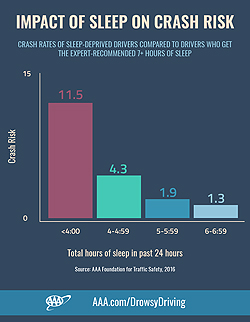Modified: December 16, 2016 4:54pm
Latest News

PRESS RELEASE
From the Office of the Commissioner of Health, Dr. Gale R. Burstein
Date: December 16, 2016
CONTACT: Mary C. St. Mary/Mary.StMary@Erie.Gov
Phone: 716.858.4941/ Mobile: 716.253.3925
Drowsy Driving Can Be Deadly
Whether a Short or Long Drive, Be Well-Rested
ERIE COUNTY, NY—According to The AAA Foundation for Traffic Safety, sleep-deprived drivers are almost twice as likely to be involved in an accident when they receive 5-6 hours of sleep, more than four times as likely with 4-5 hours and nearly 12 times more likely to crash with less than 4 hours of sleep. As many as 7% of all motor vehicle accidents (“MVAs”), 13% of MVAs resulting in hospital admission, and 21% of fatal MVAs involve driver drowsiness. 
Additional statistics are just as staggering. The National Highway Traffic Safety Administration (“NHTSA”) estimates that each year 100,000 MVAs are reported to police nationally in which drowsy driving or driver fatigue is cited as a contributing factor. NHTSA estimates that those MVAs result in 1,550 deaths, 71,000 injuries and $12.5 billion in losses annually.
“Just like drunk, drugged or distracted driving, drowsy driving can have deadly consequences,” said Erie County Commissioner of Health, Dr. Gale Burstein. “Please be alert to the warning signs of fatigue, and if you are feeling drowsy behind the wheel, switch drivers or – if you are driving alone – find a safe area to pull over and get some sleep.”
The warning signs of drowsy driving include repeated yawning; struggling to keep one’s eyes open and focused; forgetting the last few miles driven; tailgating or missing traffic signals; and swerving or drifting between lanes of traffic.
Anyone can be at risk for drowsy driving, but groups most at risk for crashes due to drowsy driving include: commercial drivers, including tractor trailer, tour bus and public transit drivers; people who work long hours in late night shifts; people with sleep disorders; new parents or caregivers of infants and young children; high school and college students, and young and newer drivers.
“The dangers of drowsy driving, particularly during this time of year, cannot be overlooked,” added Burstein. “Making sure drivers are fully rested before getting behind the wheel will help ensure that you arrive at your holiday destination safe and sound.”
State Health Commissioner Dr. Howard Zucker said, “Driving while drowsy is every bit as dangerous as driving while intoxicated and can, in the blink of an eye, forever alter or destroy a life. We urge all motorists to be aware of the symptoms of drowsy driving and know when to take breaks or share driving responsibilities.”
Sleepiness can slow a driver’s reaction time, increasing the odds of an accident, as well as impair vision and judgment and delay the processing of information. Motorists should get adequate sleep before driving, take a break about every 100 miles or two hours and bring a passenger to help keep them awake and share the driving responsibilities. Do not drink alcohol before driving, and always be aware of the potential side effects of any medications. Passengers can play a role in preventing drowsy driving too, by making sure the driver is alert and offering to take turns driving if the driver appears fatigued.
The common strategies to avoid drowsiness, such as opening a window, turning on air conditioning or playing loud music, should not be relied upon to overcome fatigue. It can take a half-hour to feel the effects of caffeine which provides only a short-term increase in driver alertness. Pull over and find a safe place for a nap or to sleep for the night is the smartest and safest action for drivers experiencing drowsiness.
# # #
For More Information:
National Sleep Foundation: Drowsing Driving
The AAA Foundation for Traffic Safety—Acute Sleep Deprivation and Crash Risk

